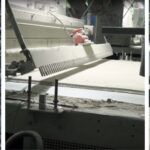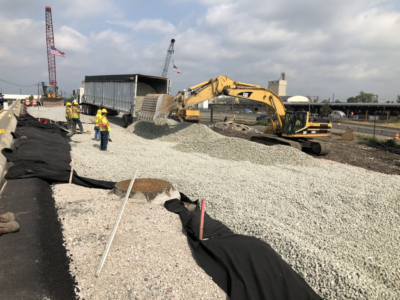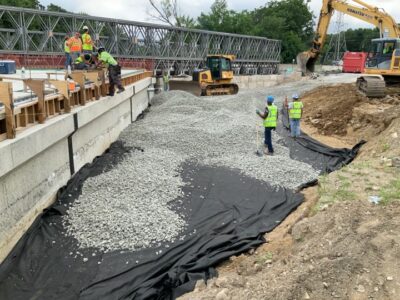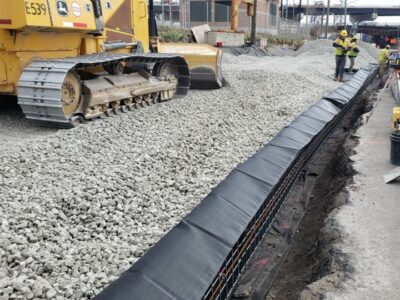Under the FHWA’s Climate Challenge, state DOTs and local agencies receive training and work with various stakeholders including those from industry and academia to implement projects that quantify the environmental impacts of pavements using Life Cycle Assessment (LCA) and Environmental Product Declarations (EPDs). EPDs provide an in-depth look at the use effects and environmental impacts of materials, processes, and mixtures. With a general goal to reduce carbon emissions, DOTs are moving towards the use of EPDs for selecting pavement uses and processes.
We spoke with Nusrat Morshed, Project Engineer in the Pavement Design & Technology Unit at NJDOT, about two FHWA project grants funded under the Climate Challenge initiative that she supervises. Both projects focus on the potential use of EPDs and LCA in New Jersey and will allow for NJDOT to develop a strong baseline understanding of EPD use.
FHWA – Funded Climate Challenge Projects
Q. Can you tell us about two FHWA-funded Climate Challenge projects listed for New Jersey. How is NJDOT currently involved in these FHWA funded projects? What are tasks for these projects?
A. NJDOT applied for this research project funding in early 2023 after the advertisement was released. I had spoken with representatives from Rowan University and Rutgers University to gauge their interest in this research, and both were on board. EPDs is a very new concept and term within the transportation field. This made it challenging to determine what the project scope should be for our grant applications. We received funding from FHWA immediately, but there were some technical issues in the allocation of state and federal funding shares that we needed to sort out before we could proceed. Both research teams officially began work in September and October of 2023 and they will have until the end of 2024 to carry out the work.
The research team for Project 1, Utilization of EPDs and LCAs to Promote Sustainability in NJ’s Pavements, is led by Dr. Yusuf Mehta from Rowan University and they are teamed with the research sub-consultant, Advanced Infrastructure Design (AID). The objective of this project is to utilize EPDs and LCAs to promote consideration of sustainability in maintaining NJDOT’s pavement infrastructure. The tasks within this project scope include: conducting a literature review, defining the goals and scope of the comparative LCA analysis, data collection, and analysis of results and interpretation.
The research team for Project 2, Improve Sustainability of Asphalt Pavement Overlay in NJ, is led by Dr. Hao Wang from Rutgers University. The research project objective is to improve the sustainability of asphalt pavement overlay in New Jersey. The project’s basic tasks include: documenting experiences and lessons of using FHWA’s LCA PAVE tool based on analysis of pavement overlay project in New Jersey DOT, evaluating quantification methods for calculating carbon emissions at the use phase of pavement, providing recommendations for use of LCA in decision making of pavement overlays, and preparing a final report and presentation.
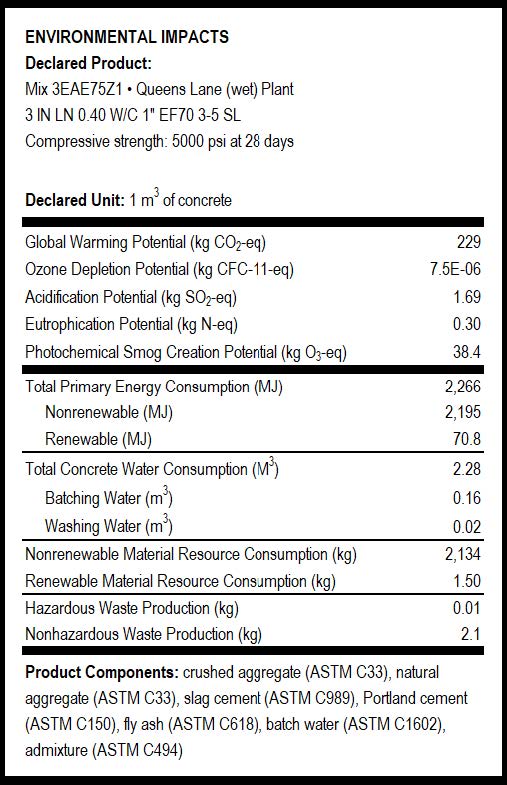
I am the key point person for both projects.
Q. What is the status of these FHWA funded projects? What resources have been helpful so far?
A. Both projects are underway now but still in the early stages. I received a status report from Project 1 about a month ago and expect a status report from Project 2 before March. For both projects, the focus has been to complete a literature review. One resource that was particularly helpful was the National Asphalt Pavement Associations (NAPA) website, as they have a lot of information on EPDs — 15 EPDs thus far have been identified — which are NJDOT specifications. We have also reached and had a meeting with the Port Authority of New York and New Jersey (PANYNJ) to get information on their own EPD process.
Q. The FHWA Climate Challenge program seems like it has established an approach to promote knowledge sharing and fostering a community of practice. Can you tell us about it?
A. Every quarter, FHWA conducts a climate challenge webinar, and on this webinar there is usually a featured presentation from an expert and then brief update presentations from climate challenge project teams. These project teams extend beyond New Jersey, so other states can hear how NJDOT is doing with these projects and we can learn from our peers in other states.
Previously our updates have been limited to 2 or 3 slides, however, later this spring I will have two reports to base our presentation upon, which will be more comprehensive and reflective of NJDOT’s progress.
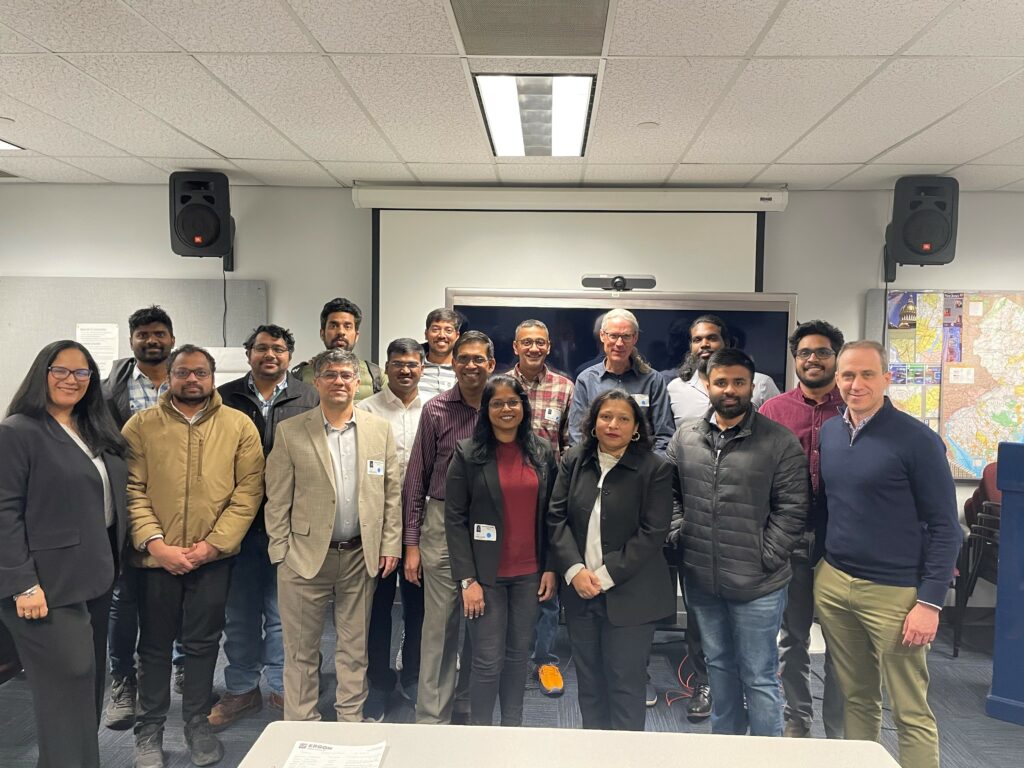
The quarterly webinars have been helpful and instructive. EPDs and sustainable resiliency are also very hot topics and several other resources are emerging that we can reference. For example, there was an entire session on EPDs at the Transportation Research Board’s Annual Meeting. Published literature has also been very helpful.
As a part of the project grants, FHWA is providing EPD-specific trainings. Both research teams and I have brainstormed about trainings our teams require. I have coordinated with FHWA as a Climate Challenge member and explained our training needs for accomplishing these two projects. FHWA and I drafted an agenda based on these research needs and we have scheduled a day and a half in-person training for March 2024. I requested that both of my teams submit their findings, as a status report before that training. So it also will be our official first status meeting for both project teams.
As a Project Engineer overseeing these projects, I am not able to work directly with the research, but I provide guidance to the universities and have been the communication bridge between them and FHWA. The training is hosted by FHWA and conducted by FHWA and a third-party organization that specializes in EPDs. These trainings are hosted throughout the U.S. To make this happen, FHWA provided us with their schedule, and we negotiated a time for them to do the training in March 2024.
Q. Who was in attendance for this training?
The training was done on March 12-13, 2024 at NJDOT. This training was focused on team members from both projects. There were representatives from the NJDOT Bureau of Materials, NJDOT Bureau of Statewide Strategies and NJDOT Division of Environmental Resources who participated.
Q. How has this funding assisted with NJDOT’s Every Day Counts (EDC) EPDs related goal?
Unless a NJ STIC Incentive Grant is awarded, FHWA does not provide any funding directly for advancing the EDC-7 innovation, but instead supports the deployment goals through the mobilization of FHWA resource specialists or subject matter experts who are farther along with innovation’s deployment. Luckily, the research of EPDs is a goal within EDC-7, so both of the funded Climate Challenge projects are indirectly supporting that EDC-7 goal.
Q. Have any pilot programs begun?
As we are still in the research stage for EPD use, we have not created any pilot programs yet.
Environmental Product Declarations in the Future
Q. Can you describe the status and implementation goal for NJDOT’s EDC-7 goal for advancing EPDs in New Jersey?
NJDOT’s EDC-7 goal for advancing EPDs in New Jersey is still in the preliminary stages of information gathering. Both of these climate challenge projects will assist with building up a robust set of literature that is necessary for next steps. Our goal is to get ideas for future recommendations. As of now, I would say we need to identify a few plants or suppliers and get some real-time data for different types of considerations based on research needs. Then we need to identify which way we can achieve EPD targets like lowering carbon emissions.
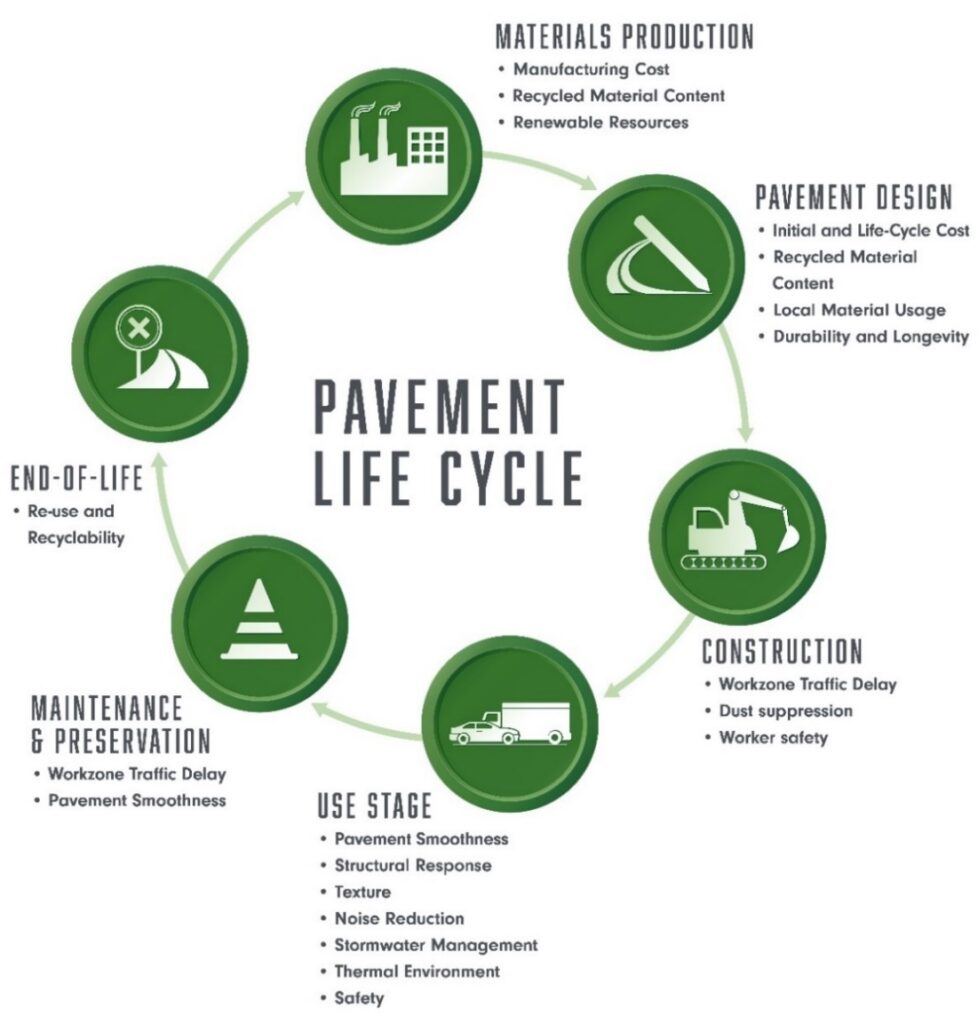
Q. What challenges, if any, has NJDOT faced while working to incorporate EPDs into pavement considerations?
EPD is based on many stages, which require their own literature review. For example, a product category rule, or a set of rules for measuring life-cycle analysis must be developed first. EPDs have different stages that all must be measured — specifically, the production stage, transportation stage and construction stage, or as they are called the A1, A2, A3. Achieving the goal of reduction in carbon emissions through EPDs requires a lot of research and literature review, and it will not be easy to get all the needed information, even when speaking with experts. Starting from scratch, the ability to quantify an EPD could take at least two years. So, it’s not that you will be getting something very quickly. We are just exploring now what is out there and how we can think about something in terms of New Jersey’s pavement mixes.
Q. How does NJDOT use or reference the published EPDs in New Jersey as reported by the National Asphalt Pavement Association’s Emerald Eco-Label tool?
We have looked at the National Asphalt Pavement Association (NAPA) website and reviewed their own PAVERS tool. It has been helpful to see how they do life-cycle analysis. They have their own LCA tool and we use the FHWA LCA tool — so there will most likely be differences. The FHWA LCA tool is expected to be updated soon.
Q. Do you foresee NJDOT having an embodied carbon clause added to NJDOT contract specifications? Will contractors be expected to submit an asphalt mix that provides EPDs to be considered for future contracts?
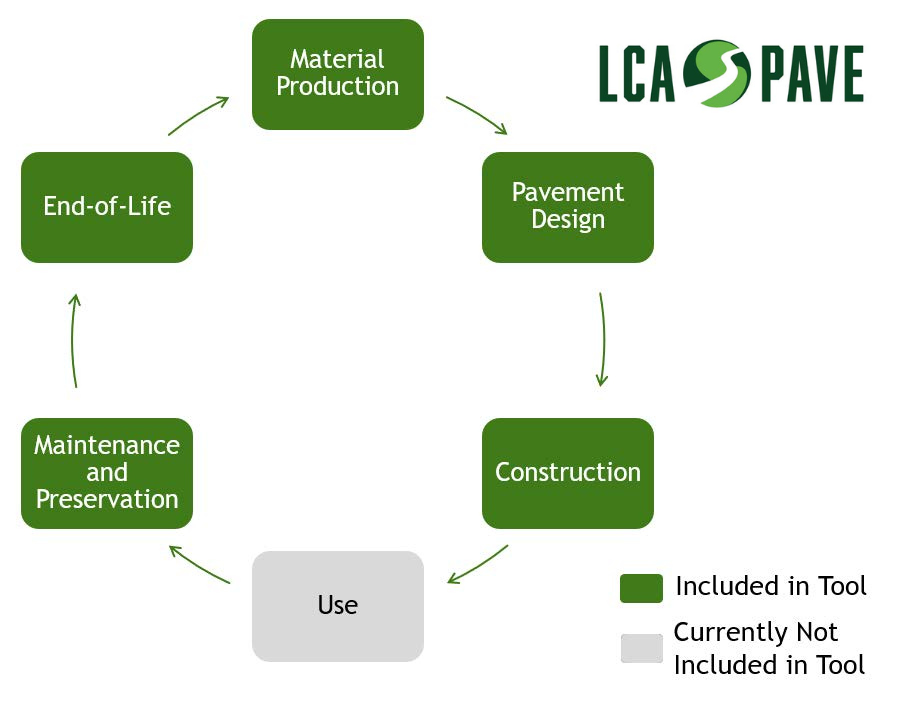
Yes, definitely, we can dream, but it will take time. We need to identify and set the product category rule. More research is needed, maybe there will be future training opportunities on this topic from FHWA.
Q. Where is the biggest research gap when it comes to the incorporation and use of EPDs? Is it research on the pavement itself, or life cycle analysis, or something else?
EPD is not a single term, but a combination of a lot of things. In the process of determining an EPD for one pavement treatment, you must consider the process of installation, the type of pavement or asphalt mix, the binder and aggregate within the mix, etc. Because each of these processes require their own considerations, we must make the decision on what process and pavement, or asphalt mix should be evaluated first. We can then use our results to determine where the use of EPDs would be most helpful, or which process should be studied next. In other words, we cannot do everything at once, but rather start very specifically and focused, and then move out.
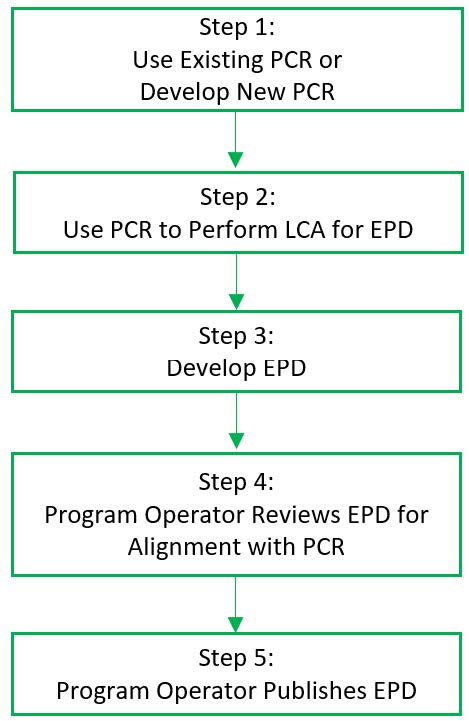
Q. Has NJDOT had an opportunity to use or test the FHWA LCA Pave Tool? If so, how does it use the tool?
I have used that tool before, but I just use it as a general gauge as I don’t have any real-time data currently. I will need training in the future on how to efficiently use the tool based on actual data. I also think this tool will be helpful in the future for determining if our results are realistic. Our research team members are using this tool.
Q. How are you feeling about this initiative?
As a state government employee, I see this initiative as an effort that will help NJDOT be aligned with NJ’s clean energy policies. EPDs are a new topic for us, and everyone is very interested in learning more about it, including me. The funding opportunity that FHWA provided allows DOTs throughout the U.S. to explore this new topic and determine its applicability in the future of pavement and asphalt design.
Resources
FHWA Climate Challenge – Quantifying Emissions of Sustainable Pavements. FHWA webpage. Retrieved at https://www.fhwa.dot.gov/infrastructure/climatechallenge/projects/index.cfm
LCA Pave Tool. FHWA webpage. Retrieved at https://www.fhwa.dot.gov/pavement/lcatool/
Emerald Eco-Label. Webpage. Retrieved at https://asphaltepd.org/published?state=NJ
What is Environmental Product Declaration (EPD) for Sustainable Project Delivery? Webpage. Retrieved at: https://www.njdottechtransfer.net/epds-for-sustainable-project-delivery/
Life Cycle Assessment: Part I Fundamentals. Webinar, FHWA Sustainable Pavements Webinar Series. Retrieved at: https://youtu.be/uaJ8wGMAPD0?si=oBHnBSN2K1589JEa
An Introduction to Life Cycle Assessment: Part II – EPDs and PCRs, FHWA Sustainable Pavements Webinar Series. Retrieved at: https://www.youtube.com/watch?v=Y4OqVR6U2Us
Sustainable Pavements Program. FHWA Webpage. Retrieved at https://www.fhwa.dot.gov/pavement/sustainability/
Sustainability Analysis: Environmental. Life Cycle Assessment (LCA). FHWA Webpage. Retrieved at: https://www.fhwa.dot.gov/pavement/sustainability/environmental/
Meijer, J., Harvey, J., Butt, A., Kim, C., Ram, P., Smith, K., & Saboori, A. (2021). LCA Pave: A Tool to Assess Environmental Impacts of Pavement Material and Design Decisions-Underlying Methodology and Assumptions (No. FHWA-HIF-22-033). United States. Federal Highway Administration. Retrieved at: https://www.fhwa.dot.gov/pavement/lcatool/LCA_Pave_Tool_Methodology.pdf
Milleer, Lianna; Ciaviola, Benjamiin and Mukherjee, Amlan. (February 2024). EPD Benchmark for Asphalt Mixtures, SIP-108. Prepared for National Asphalt Pavement Association by WAP Sustainability. Retrieved at: https://www.asphaltpavement.org/uploads/documents/EPD_Program/NAPA-SIP108-EPDBenchmarkForAsphaltMixtures-Feb2024.pdf’


